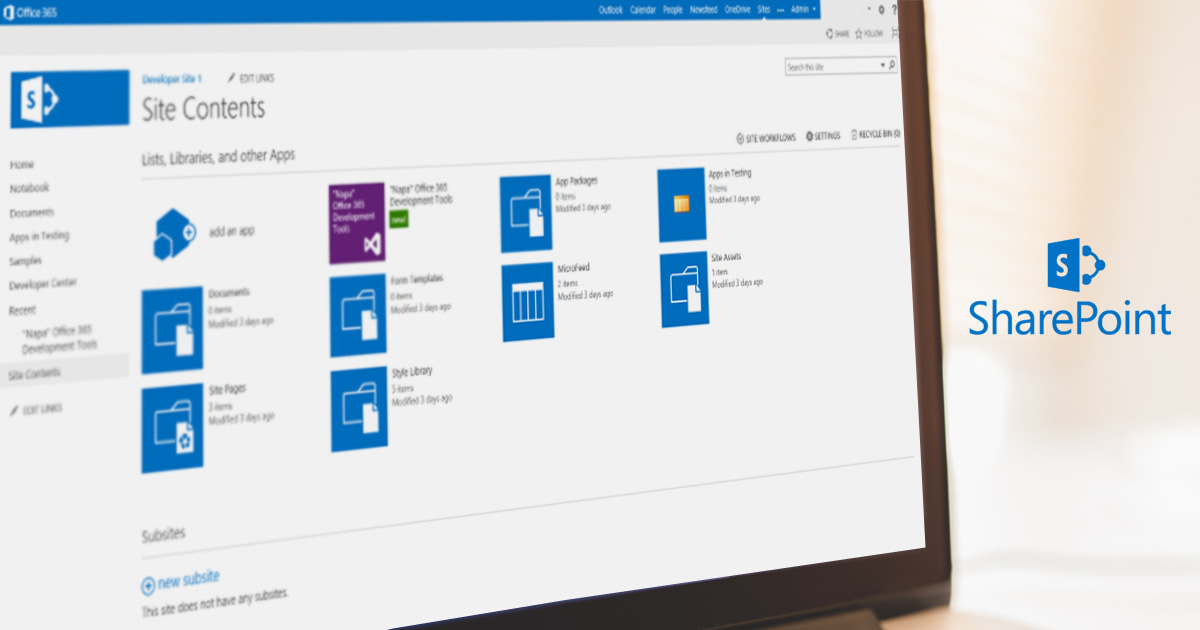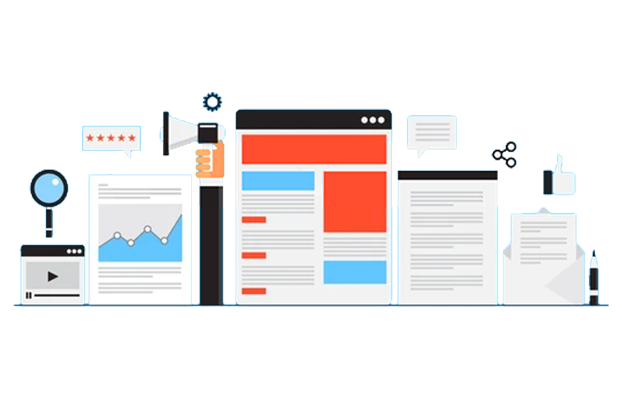Content Types consist of the foundation of information architecture planning in SharePoint and are one of the primary building blocks. A Content-Type is a collection of reusable settings and metadata for the category, item, or document in Microsoft SharePoint that can be applied to certain categories of content. Content Types may represent groups of items like documents, lists, or calendar entries.
Businesses constantly churn out content daily in the form of proposals, specifications, legal contracts, statements of work, etc. Information produced has some amount of value if it can be relocated later. However, many businesses lack an effective, systematic way of storing and retrieving their content. Thankfully, SharePoint offers a unique way to organize and manage such content systematically across your site through Content Types.

Content Types and Metadata
Content Types are defined and identified by their metadata – information about data. Generally, metadata describes the context of a document, such as title, author, date of creation, format, size, associated department, or even the font size.
Metadata exists in SharePoint columns to identify and find content. Managing, organizing, and linking documents, determining access controls, moving between categories of information, refining search results, and, most importantly, classifying information is primarily dependent on this metadata.
The Working of Content Types
Content Types work by organizing information that largely shares the same set of behaviors. For instance, HR documents like employee enrollment documents, employee induction documents, employee manuals, and HR policies. Although these documents are different, there is a small set of metadata that applies to all of them so they can be reused, shared, and retained for future use.
Consider the diverse array of documents managed by an HR department—each type, from employee enrollment forms to policy manuals, plays a critical role in organizational operations. Despite their differences, these documents share a set of common metadata attributes, such as employee name, department, and document expiry date, which are essential for categorization, searchability, and compliance.
Creating a primary 'Human Resource' content type as the cornerstone for HR document management enables the encapsulation of these shared attributes. This foundational content type acts as a template, ensuring consistency and governance across all HR-related documents.
Further refinement is achieved by developing specialized sub-types for different categories of HR documents. For example, an 'Employee Manual' content type might include unique fields such as revision number or audience, while an 'Employee Enrollment' content type could require specific metadata like enrollment date and benefit options. These specialized content types inherit the general attributes from the 'Human Resource' parent type but are tailored to address the nuances of each document category.
This hierarchical structure of content types facilitates several key benefits:
- Efficiency in Document Creation: Automated templates and predefined metadata fields streamline the creation of new documents.
- Enhanced Searchability and Retrieval: By using consistent metadata across documents, employees can quickly find the information they need.
- Governance and Compliance: Ensuring that each document type adheres to regulatory requirements and internal policies becomes simpler when using a structured content-type framework.
Moreover, workflows can be attached to these content types to automate processes such as document approval, review cycles, and archiving. This not only saves time but also enhances compliance and reduces the risk of human error.
Site and List Content Types
Content Types can be organized in a hierarchy to allow one content type to inherit characteristics from its parent content type. These characteristics are mainly document templates, read-only settings, workflows, or columns. Content Types can be defined and managed at two levels in the hierarchy:
- Level 1 – Site Level – Content Types defined at the site level that are also available to the site collection. New and existing Content Types can be found in the Galleries section of Site Settings or achieved programmatically. Site-Level Content Types can also be added to lists or libraries individually where they can be further customized.
- Level 2 – List Level – Content Types that are added to a list or library. List-Level Content types inherit all properties of Site-Level Content Types. Hence, Site-Level Content Types act as parents to List-Level Content Types in the hierarchy. Multiple Content Types can be added to a list or library.
Creating and Managing Content Types
The evolution of SharePoint's interface to a more modern, user-friendly design marks a significant leap toward simplifying content management. The updated process, accessible through both the Admin Center and Site Gallery, streamlines the creation and customization of content types.
This modern approach not only enhances efficiency but also enriches the user experience by making it easier to navigate and apply necessary configurations. Such configurations include the quick addition of metadata and settings essential for categorizing and managing the flow of information. This evolution shows SharePoint’s focus on the democratization of content governance, making it more approachable and less scary to all users with various levels of technological capability.
With these improvements, SharePoint strengthens its role as the core aspect of organizational content management and governance.
Integration Across Microsoft 365
Suppose SharePoint is the starting and linking point of all your work. When it integrates with Microsoft Teams, you have a very powerful combination for team collaboration – discussions, meetings, and file sharing all happen in one place, directly associated with your SharePoint content.
Finally, there is OneDrive which ensures that accessing and sharing documents is a piece of cake whether you are at the office or on the go. This connectedness means less time spent in search of files and more time that can be used for productive work.
SharePoint solution does not require you to simply work with the tools, you work alongside these tools, and they are working as an integrated unit, streamlining the whole workflow. It is more than only eliminating individual tasks; it is about changing the way teams work together, destroying silos, and ensuring that everyone has what they need immediately at hand.
Content Type Publishing and Management
The services of Managed Metadata make the management of content types more efficient throughout SharePoint as they serve as a kind of central hub. A similar issue exists for large organizations where so-called content types, which constitute a uniform consistent taxonomy across numerous site collections, must be adhered to for uniformity and compliance.
# The Publishing Process
The publishing process includes creating/ modifying content types in a Content Type Hub site, the type of site collection developed specifically for this purpose. When published out of the hub, the content types of these types become available throughout all the subscribed site collections. This provides coherence in updating or adding new content types, thus minimizing the redundancy and error in content management.
# Pros of a Single Content Strategy
- Consistency Across Site Collections: Helps to standardize content types used within each department or team within an organization, an important factor in keeping consistent metadata and content structures.
- Efficiency in Content Management: Simplifies the process of updating content types. When Content Type Hub is modified, the modifications are propagated automatically to all the subscribing sites, which eliminates the hassle of manually updating each site collection.
- Improved Search and Discovery: This standardization of content types and metadata helps organizations to improve their search capabilities, therefore, they can easily find and retrieve such content.
- Enhanced Compliance and Governance: Centralized content type management helps in enforcing compliance policies and governance plans since it is easier to apply and track compliance across all site collections.
- Simplified Content Migration and Reuse: Standard content types allow for easier content migration and reuse throughout the company, assisting in effective content lifecycle management.
Content Type Publishing, part of SharePoint’s information architecture, determines how information is classified, stored, and accessed. Using Managed Metadata, a company can create a taxonomy that will help the company’s way of dealing with information, adding more value to the content types.
The Structure of Inheritance
Site Content Types can be used globally within the site collection, while List Content Types are localized. Since a List Content Type is a child of a Site Content Type from which it is created, it inherits all attributes from its parent. When the attributes of a Site Content Type are changed, you can choose whether its child Content Types should inherit the change or not.
List Content Types can also be further customized for use in the list or library. This customization does not affect the parent. If new changes are pushed from a Site Content Type, any customizations on the List Content Type are not overwritten.
Content Types are an integral part of SharePoint that enable organizations to better manage and consistently handle their content. This makes these organizations more efficient, accurate, and better able to function. The information covered here is just the basics of working with Content Types. Our team will cover more aspects of Content Types in future articles.
Call us at 484-892-5713 or Contact Us today to know more details about beginner's guide to SharePoint content types.


